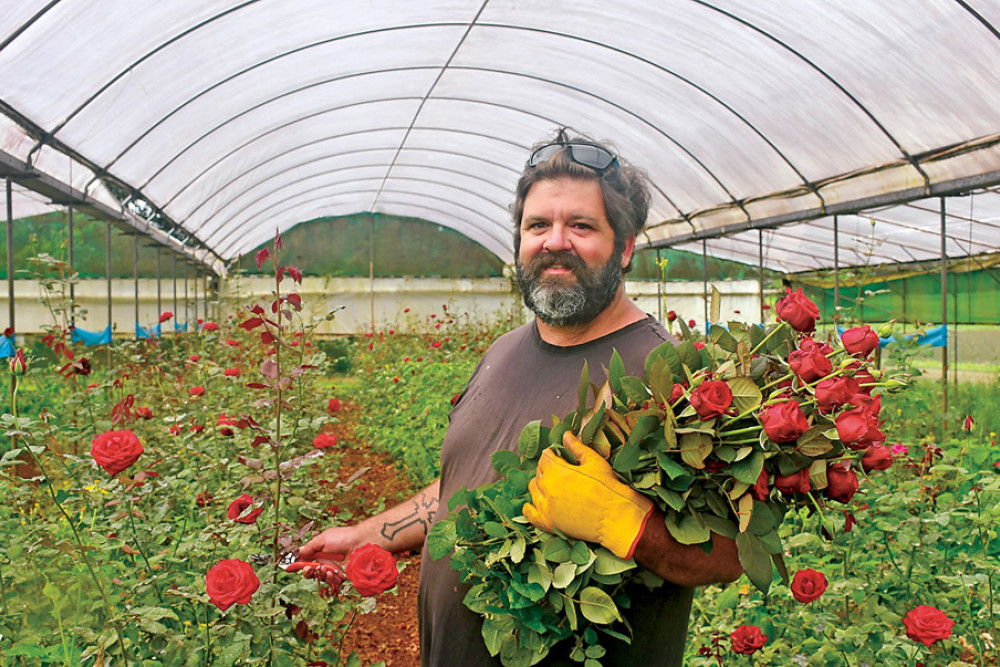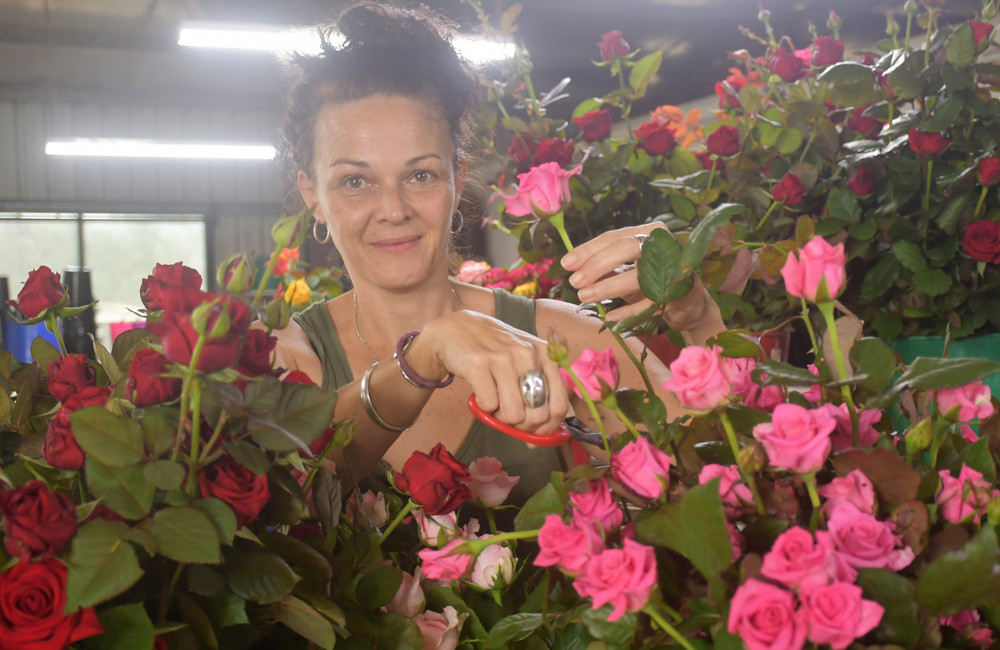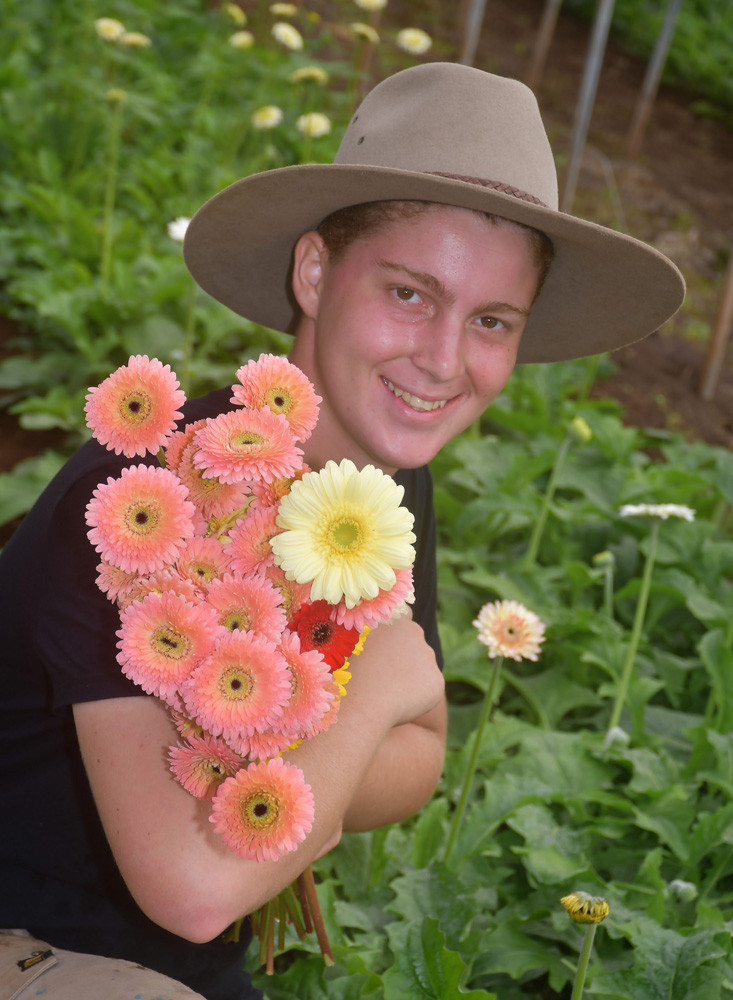General News
28 January, 2023
Flower farm a labour of love
GROWING flowers for a living sounds like a dream come true, but the work, commitment and costs that go into producing the beautiful blooms we all love to receive is evident when you talk to Paul and Torquay Daly of Roseburra Flower Farm near Yungaburra.

The couple purchased the farm in 2019 but admit they didn’t have any background in growing flowers, with Paul previously growing blueberries for the Costa Group.
“It was probably the best farm on the market at the time – the others were rundown avocado and mango orchards so this had the best value,” Paul said.
Paul has pretty much educated himself on flower production, doing research online and learning what works from hands-on experience.
“It’s very similar to growing fruit – they have similar diseases to fruit, so you’re tackling the same issues, whether it’s pumpkins, peanuts or flowers,” he said.
About two hectares of the property is currently under production, with numerous “tunnels” hosting roses, gerberas, carnations and a variety of filler species.
“Since we have been here, we’re put another hectare of tunnels in for roses and gerberas,” Paul said.
A labour-intensive operation, the flowers need constant care and attention to deliver the blooms the farm needs to cater to numerous florists from Mossman in the north to Mackay in the south.
But pests and diseases are always challenging and keep the couple and their five full-time staff busy.
“The biggest issue we have had during our time here was about four months back when the pest and disease pressure was getting to much – we had down mildew which drops all the leaf off your plants and we also had some thrips and mites,” he said.
“Because flowers are not selling at that time, it was more cost effective to prune them right back.
“The cost of the chemical has gone through the roof so we would have had to spend thousands of dollars for a product that that we wouldn’t be able to sell.”
The end result was 80 per cent of their roses had to be pruned back and with Valentine’s Day – their biggest sales day of the year – looming, it was all hands on deck to get the plants pruned down to knee height.

“They are all ready now because you get a quick turnaround - it takes about six weeks but it also depends on your plant height and how much leaf you’ve got on there to photosynthesise and give back to the next flower,” Paul said.
“When you prune them hard, they will be dormant for a bit, so it was six weeks, we pruned them again, then six weeks later, we pruned them again.”
Even when the couple find a few days for a well-earned break, the farm is always foremost in their mind.
“We went away last week and at the time we were fighting the monolepta beetle which swarms and decimates the plants, eating all the leaves and just leaving the skeleton," Paul said.
“We had to get right on and spray and while we were away, we were on the phone every day making sure the farm was all good. We got home Sunday and by 3pm, I was out spraying again."
With Valentine’s Day just a couple of weeks away, everyone is focussed on ensuring the farm can meet its full production.
“We have five full-time but we get extra people in for Valentine’s Week, and all maintenance stops for a two-week period while they are doing that, then we play catch up for the next month, then we prune for Mother’s Day, then we play catch up in winter, and reset for spring and summer,” Paul said.
To produce the best blooms possible, a lot of work goes into ensuring the plants are healthy, with fertiliser applied three times a week, despite the fact that the fertiliser they use has risen in price by 42 per cent.
The plants are also watered every day except during the wet season, but at the moment it’s the lack of sun that is hampering growth.
“It’s a bit of an uphill battle with the weather – we can get too much rain, and it’s is a little bit of worry about how much cloud cover we having at the moment, because we grow under plastic anyway, which means the light is already diffused so were losing up to 30 per cent of light to begin with, then on a cloudy day, another 15 per cent, and roses need a minimum of six hours of sunlight a day,” Paul said.
“Over a 12-hour day, we’re probably only getting four to six hours so we’re hoping for some fine weather.”
Every five years or so, the rose plants have to be replaced, with new plants procured from Victoria.
“We got about 10,000 last time but will probably get a couple of thousand next time,” Paul said.
“They are very young when they come up so they get a bit of a shock (to the weather) to start with, but within a couple of weeks they adjust.”
Unlike roses that are imported, around 4-5 varieties at Roseburra still have a wonderful scent.
“Over the years, the scent has been bred out of many roses because the flower will last longer but it’s also to make the plant pest and disease resist-ant,” Paul said.
The farm currently produces around eight colours in roses, and 10 different colours for gerberas including variegated ones. Baby’s breath, misty, Sweet Williams, and amaranthus are grown for fillers.
With only a few flower farms left on the Tablelands, Paul said it was vital that consumers supported Australia-grown product.
“There were quite a few up here but they have folded as have many around the country due to imports,” he said.
“The florists are supporting the wholesalers who are getting their flowers imported and we can’t match them – countries like Kenya and Columbia, they don’t have laws like us on wages, we can’t compete when they are paying a $1 a day to their workers.
“They don’t have the same regulations we do as to what you can spray the flowers with – they spray with some pretty heavy chemicals overseas and these can have carcinogens and guess what the first thing people do when they get flowers? They take a big smell of those flowers and they could be breathing in those pesticides.
“I wish the government would push for origin labels – you go into supermarkets, you don’t know where they come from – they must be imported because you can’t get a price that cheap (from local growers).

Paul believes flowers will never go out of fashion, especially for weddings, funerals and special days of the year, even though for some consumers, the cost of them may be getting too high.
Because flowers have to be packed in layers in boxes to be transported from overseas, they go without water for up to two weeks, according to Paul, whereas locally grown flowers may only be without water for two days while they are being transported to florists.
“As a general rule, our flowers can last up to two weeks, but you can often buy flowers and they only last two days. Money is tight at the moment and people will not want to buy a luxury product that’s only going to be there for a few days,” he said.
“So, if you’re going to buy flowers, buy local because you’re not just supporting local families, you’re getting a much fresher product that will last longer and without any dangerous chemical being used on them.”


